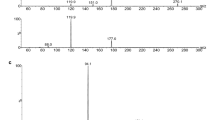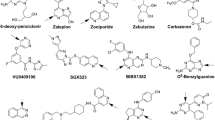Abstract
Purpose
Metarrestin is a first-in-class pyrrolo-pyrimidine-derived small molecule targeting a marker of genome organization associated with metastasis and is currently in preclinical development as an anti-cancer agent. Here, we report the in vitro ADME characteristics and in vivo pharmacokinetic behavior of metarrestin.
Methods
Solubility, permeability, and efflux ratio as well as in vitro metabolism of metarrestin in hepatocytes, liver microsomes and S9 fractions, recombinant cytochrome P450 (CYP) enzymes, and potential for CYP inhibition were evaluated. Single dose pharmacokinetic profiles after intravenous and oral administration in mice, rat, dog, monkey, and mini-pig were obtained. Simple allometric scaling was applied to predict human pharmacokinetics.
Results
Metarrestin had an aqueous solubility of 150 µM at pH 7.4, high permeability in PAMPA and moderate efflux ratio in Caco-2 assays. The compound was metabolically stable in liver microsomes, S9 fractions, and hepatocytes from six species, including human. Metarrestin is a CYP3A4 substrate and, in mini-pigs, is also directly glucuronidated. Metarrestin did not show cytochrome P450 inhibitory activity. Plasma concentration–time profiles showed low to moderate clearance, ranging from 0.6 mL/min/kg in monkeys to 48 mL/min/kg in mice and moderate to high volume of distribution, ranging from 1.5 L/kg in monkeys to 17 L/kg in mice. Metarrestin has greater than 80% oral bioavailability in all species tested. The excretion of unchanged parent drug in urine was < 5% in dogs and < 1% in monkeys over collection periods of ≥ 144 h; in bile-duct cannulated rats, the excretion of unchanged drug was < 1% in urine and < 2% in bile over a collection period of 48 h.
Conclusions
Metarrestin is a low clearance compound which has good bioavailability and large biodistribution after oral administration. Biotransformation appears to be the major elimination process for the parent drug. In vitro data suggest a low drug–drug interaction potential on CYP-mediated metabolism. Overall favorable ADME and PK properties support metarrestin’s progression to clinical investigation.




Similar content being viewed by others
Materials availability
Metarrestin is available from AOBIOUS, Glixx Laboratories Inc, US Biological Life Sciences under the name ML-246.
Abbreviations
- ADME:
-
Absorption, distribution, metabolism and excretion
- CLint :
-
Intrinsic clearance
- CLp :
-
Plasma clearance
- CLND:
-
Chemiluminescent nitrogen detection
- CYP:
-
Cytochrome P450
- F :
-
Bioavailability
- HP-β-CD:
-
2-Hydroxypropyl-β-cyclodextrin
- IV:
-
Intravenous
- P app :
-
Apparent permeability
- PK:
-
Pharmacokinetics
- PNC:
-
Peri-nucleolar compartment
- ROE:
-
Rule of exponents
- SA:
-
Simple allometry
- t 1/2 :
-
Elimination half-life
- Vdss :
-
Volume of distribution at steady-state
References
Seyfried TN, Huysentruyt LC (2013) On the origin of cancer metastasis. Crit Rev Oncog 18(1–2):43–73
Steeg PS (2016) Targeting metastasis. Nature Rev Cancer 16(4):201–218
Weber GF (2013) Why does cancer therapy lack effective anti-metastasis drugs? Cancer Lett 328(2):207–211
Ma J, Jemal A (2013) The rise and fall of cancer mortality in the USA: why does pancreatic cancer not follow the trend? Future Oncol 9(7):917–919
Tevaarwerk AJ, Gray RJ, Schneider BP et al (2013) Survival in patients with metastatic recurrent breast cancer after adjuvant chemotherapy: little evidence of improvement over the past 30 years. Cancer 119(6):1140–1148
Bernards N, Creemers GJ, Nieuwenhuijzen GA, Bosscha K, Pruijt JF, Lemmens VE (2013) No improvement in median survival for patients with metastatic gastric cancer despite increased use of chemotherapy. Ann Oncol 24(12):3056–3060
Frankowski K, Patnaik S, Schoenen F, et al. Discovery and development of small molecules that reduce PNC prevalence. Probe reports from the NIH Molecular Libraries Program. Bethesda: National Center for Biotechnology Information; 2010.
Frankowski KWC, Patnaik S, Schoenen F, Southall N, Teper Y, Sun W, Kandela I, Huf D, Dextras C, Norton J, Titus J, Lewandowska M, Wen Y, Farley KI, Mathews Greiner L, Sultan J, Meng Z, Zhou M, Fang M, Long C, Khanolkar O, Chen W, Kang J, Huang H, Chow E, Goldberg E, Feldman E, Xi R, Kim HR, Sahagian G, Baserga SJ, Mazar A, Ferrer M, Zheng W, Shilatifard A, Aubé J, Rudloff U, Marugan JJ, Huang S (2018) Metarrestin, a potent perinucleolar compartment inhibitor, effectively suppresses metastasis. Sci Transl Med 10(441):eaap8307
Norton JT, Titus SA, Dexter D, Austin CP, Zheng W, Huang S (2009) Automated high-content screening for compounds that disassemble the perinucleolar compartment. J Biomol Screen 14(9):1045–1053
Pollock C, Huang S (2009) The perinucleolar compartment. J Cell Biochem 107(2):189–193
Norton JT, Huang S (2013) The perinucleolar compartment: RNA metabolism and cancer. Cancer Treat Res 158:139–152
Norton JT, Pollock CB, Wang C, Schink JC, Kim JJ, Huang S (2008) Perinucleolar compartment prevalence is a phenotypic pancancer marker of malignancy. Cancer 113(4):861–869
Kamath RV, Thor AD, Wang C et al (2005) Perinucleolar compartment prevalence has an independent prognostic value for breast cancer. Cancer Res 65(1):246–253
Slusarczyk A, Kamath R, Wang C et al (2010) Structure and function of the perinucleolar compartment in cancer cells. Cold Spring Harb Symp Quant Biol 75:599–605
Vilimas T, Wang AQ, Patnaik S et al (2018) Pharmacokinetic evaluation of the PNC disassembler metarrestin in wild-type and Pdx1-Cre;LSL-Kras(G12D/+);Tp53(R172H/+) (KPC) mice, a genetically engineered model of pancreatic cancer. Cancer Chemother Pharmacol 82(6):1067–1080
Kestranek A, Chervenak A, Longenberger J, Placko S (2013) Chemiluminescent nitrogen detection (CLND) to measure kinetic aqueous solubility. Curr Protoc Chem Biol 5(4):269–280
Sun H, Nguyen K, Kerns E et al (2017) Highly predictive and interpretable models for PAMPA permeability. Bioorganic Med Chem 25(3):1266–1276
Obach RS, Baxter JG, Liston TE et al (1997) The prediction of human pharmacokinetic parameters from preclinical and in vitro metabolism data. J Pharmacol Exp Ther 283(1):46–58
Mahmood I, Balian JD (1996) Interspecies scaling: predicting clearance of drugs in humans three different approaches. Xenobiotica 26(9):887–895
Mahmood I (1999) Prediction of clearance, volume of distribution and half-life by allometric scaling and by use of plasma concentrations predicted from pharmacokinetic constants: a comparative study. J pharm pharmacol 51(8):905–910
Brown MW, Maldonado AL, Meredith CG, Speeg KV Jr (1985) Effect of ketoconazole on hepatic oxidative drug metabolism. Clin Pharmacol Therap 37(3):290–297
Szakacs G, Paterson JK, Ludwig JA, Booth-Genthe C, Gottesman MM (2006) Targeting multidrug resistance in cancer. Nat Rev Drug Discov 5(3):219–234
Giuliano C, Jairaj M, Zafiu CM, Laufer R (2005) Direct determination of unbound intrinsic drug clearance in the microsomal stability assay. Drug Metab Dispos 33(9):1319–1324
Nordell P, Svanberg P, Bird J, Grime K (2013) Predicting metabolic clearance for drugs that are actively transported into hepatocytes: incubational binding as a consequ7ence of in vitro hepatocyte concentration is a key factor. Drug Metab Dispos 41(4):836–843
Chen S, Prieto Garcia L, Bergstrom F, Nordell P, Grime K (2017) Intrinsic clearance assay incubational binding: a method comparison. Drug Metab Dispos 45(4):342–345
Lee SJ, Bell DA, Coulter SJ, Ghanayem B, Goldstein JA (2005) Recombinant CYP3A4*17 is defective in metabolizing the hypertensive drug nifedipine, and the CYP3A4*17 allele may occur on the same chromosome as CYP3A5*3, representing a new putative defective CYP3A haplotype. J Pharmacol Exper Therap 313(1):302–309
Hansen AR, Graham DM, Pond GR, Siu LL (2014) Phase 1 trial design: is 3 + 3 the best? Cancer Control 21(3):200–208
Mahmood I, Boxenbaum H (2014) Vertical allometry: fact or fiction? Regul Toxicol Pharmacol 68(3):468–474
Tang H, Mayersohn M (2007) Utility of the coefficient of determination (r2) in assessing the accuracy of interspecies allometric predictions: illumination or illusion? Drug Metab Dispos 35(12):2139–2142
Tang H, Hussain A, Leal M, Mayersohn M, Fluhler E (2007) Interspecies prediction of human drug clearance based on scaling data from one or two animal species. Drug Metab Dispos 35(10):1886–1893
Funding
This research was supported in part by the Intramural Research Program of the National Center for Advancing Translational Sciences, National Institutes of Health. This Research was supported by the Intramural Research Program of the NIH, National Cancer Institute, Center for Cancer Research (ZIA BC 011267), donations from ‘Running for Rachel’ and the Pomerenk family via the Rachel Guss and Bob Pomerenk Pancreas Cancer Research Fellowship. The content of this publication does not necessarily reflect the views or policies of the Department of Health and Human Services, nor does mention of trade names, commercial products, or organizations imply endorsement by the U.S. Government.
Author information
Authors and Affiliations
Corresponding authors
Ethics declarations
Conflict of interest
SP and JM are Inventors on Patent entitled “Compounds and methods for the prevention and treatment of tumor metastasis and tumorigenesis” (US9663521B2). A provisional patent application entitled “Formulations and methods for the prevention and treatment of tumor metastasis and tumorigenesis” has been filed (WO2019222380A1). Inventors include UR, JM, and SP. All the other authors declare that they have no competing interest.
Additional information
Publisher's Note
Springer Nature remains neutral with regard to jurisdictional claims in published maps and institutional affiliations.
Electronic supplementary material
Below is the link to the electronic supplementary material.
280_2020_4042_MOESM1_ESM.pptx
Supplementary file1 Impact of metarrestin on CYP2 and CYP3 metabolism. Examined CYP isoform shown on top, known substrate and metabolite depicted on bottom. Impact by known inhibitor on CYP function (used as positive control) shown in blue curves, impact on CYP metabolism by metarrestin indicated by orange and red dose response curves (in triplicates).
Rights and permissions
About this article
Cite this article
Padilha, E.C., Shah, P., Wang, A.Q. et al. Metabolism and pharmacokinetics characterization of metarrestin in multiple species. Cancer Chemother Pharmacol 85, 805–816 (2020). https://doi.org/10.1007/s00280-020-04042-y
Received:
Accepted:
Published:
Issue Date:
DOI: https://doi.org/10.1007/s00280-020-04042-y




